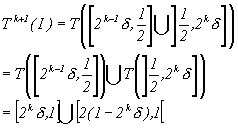Theorem Assume that ![]() and |(f n)’(p)| < 1. Then there is an open interval
and |(f n)’(p)| < 1. Then there is an open interval ![]() such that for every
such that for every ![]() :
:
![]()
Proof: By the assumption ![]() , i.e. f has a continuous derivative and is continuous for every xÎ [a,b], where [a,b] is a closed subset of Â
. Then there exists an e
>0 such that |(fn)’(x)|<A<1 for xÎ
[p-e
,p+e
]. The theorem is proved by induction, i.e. the theorem is first proved to hold for k=1. By the meanvalue theorem there exists a x
, |x
-p|<|x-p|, such that:
, i.e. f has a continuous derivative and is continuous for every xÎ [a,b], where [a,b] is a closed subset of Â
. Then there exists an e
>0 such that |(fn)’(x)|<A<1 for xÎ
[p-e
,p+e
]. The theorem is proved by induction, i.e. the theorem is first proved to hold for k=1. By the meanvalue theorem there exists a x
, |x
-p|<|x-p|, such that:
![]()
According to the above f n(x) is closer to p than x. The induction assumption is now:
![]()
The inequality is then proved to hold also for k+1:

Induction gives that the inequality holds for every k and the following conclusion can be done: f kn(x)® p when k® ¥.
Theorem Assume that ![]() and |(f n)’(p)| > 1. Then there is an open interval
and |(f n)’(p)| > 1. Then there is an open interval ![]() such that for every xÎU\{p} there exists kÎN such that:
such that for every xÎU\{p} there exists kÎN such that:
![]()
Proof:
By the assumption ![]() , where [a,b] is a closed subset of Â
. Then there exists an e
>0 such that |(f n)’(x)|>A>1 for xÎ
]p-e
,p+e
[. Take an arbitrary x#p from the interval ]p-e
,p+e
[ and do the antithesis that f kn(x)Î
U for all k. Then the theorem is proved by induction, i.e. the theorem is first proved for k=1. By the meanvalue theorem there exists a x
, |x
-p|£
|x-p|, such that:
, where [a,b] is a closed subset of Â
. Then there exists an e
>0 such that |(f n)’(x)|>A>1 for xÎ
]p-e
,p+e
[. Take an arbitrary x#p from the interval ]p-e
,p+e
[ and do the antithesis that f kn(x)Î
U for all k. Then the theorem is proved by induction, i.e. the theorem is first proved for k=1. By the meanvalue theorem there exists a x
, |x
-p|£
|x-p|, such that:
![]()
According to the above f n(x) is further from p than x is from p. The induction assumption is now given by:
![]()
The inequality is then proved also to hold for k+1:

Induction gives that the inequality holds for every k and the conclusion that f kn(x)® ¥ when k® ¥ can be made. The antithesis is false, which means that the proof is finished.
The tent map is chaotic on [0,1].
Proof: Consider an arbitrary interval I=[1/2d ,d ], 0<d <1/2. Now there exists a natural number k such that 2k-1d<1/2<2kd , and Tk(I)=[2k-1d , 2kd]. The next iteration of T gives:

The next iteration gives that T k+2(I)=[0,2(1-2kd)]È T([2(1-2kd ),1[). Hence 1-2kd <1/2 and there exists a number l, such that 2l(1-2kd )>1/2. The following therefore holds:
![]()
By the construction there exists a natural number k for every interval JÎ [0,1], such that T k(I)Ç J#Æ . Theorem 1.2. can now be used to finish the proof, since T(x) is continuous and topologically transitive on [0,1].
The baker map is chaotic on [0,1].
Proof: As for the tent map, it can be proved that B(x) is topologically transitive. B n(x) has 2 n fixed points, because the interval [0,1] consists of 2 n piecewise linear functions at the n:th iteration of B. Take now two n-periodical points, x and x', that are not separated by any other periodical points. The distance between these is now:
![]()
The periodical points are dense on [0,1]. The theorem 1.1. now gives that B(x) is chaotic on [0,1].
A perioddoubling occurs for the map fl (x)=lx-(l+1)x3 at l=3.

The cubic function fl (x)=lx-(l+1)x3 is chaotic for l=3.
Consider ![]() . Put
. Put ![]() and h: S1®
[-1,1].
and h: S1®
[-1,1].
Now the following holds:

i.e. f 3(h(q
))=h(g(q
)). Note that h is not a homeomorphism since it's a two-to-one at most points. The maps g and f3 are semi-conjugate [Dev89]. Hence it is proved that g is chaotic. Example 1.1. shows that ![]() has dense periodical points on the unit circle. The map g is also topological transitive, because for any neighborhood U (in S1) there exists k such that g k(U) covers S1. Hence g is chaotic which also proves that f3 is chaotic.
has dense periodical points on the unit circle. The map g is also topological transitive, because for any neighborhood U (in S1) there exists k such that g k(U) covers S1. Hence g is chaotic which also proves that f3 is chaotic.